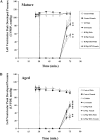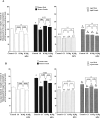Age- and gender-related differences in mitochondrial oxygen consumption and calcium with cardioplegia and diazoxide
- PMID: 17307466
- PMCID: PMC2673576
- DOI: 10.1016/j.athoracsur.2006.10.059
Age- and gender-related differences in mitochondrial oxygen consumption and calcium with cardioplegia and diazoxide
Abstract
Background: We have recently shown that the cardioprotection afforded by cardioplegia is affected by age and gender and is less effective in the aged female rabbit heart compared with the aged male rabbit heart. We hypothesized that these differences were due to age and gender-specific modulation of mitochondrial oxygen consumption and mitochondrial free matrix calcium ([Ca2+](Mito)) content occurring during early reperfusion.
Methods: To test this hypothesis, 104 male and female rabbit hearts, mature (15 to 20 weeks) and aged (>32 months), were subjected to Langendorff perfusion. Control hearts were perfused for 75 minutes. Global ischemia hearts were underwent 30 minutes of equilibrium, 30 minutes of global ischemia, and 15 minutes of reperfusion. Cardioplegia (potassium/magnesium) +/- diazoxide was infused 5 minutes before global ischemia. Mitochondria were isolated from left ventricular tissue and used for the measurement of oxygen consumption and [Ca2+](Mito).
Results: Mitochondrial oxygen consumption was significantly increased in the mature and aged female hearts in all treatment groups (p < 0.001 versus male). Cardioplegia +/- diazoxide modulated mitochondrial oxygen consumption, but these effects were significantly decreased in the aged heart and in the female heart (p < 0.001 each versus male). Cardioplegia (potassium/magnesium) significantly decreased [Ca2+](Mito) (p < 0.001 versus global ischemia) in aged but not mature hearts. The addition of diazoxide to potassium/magnesium significantly decreased [Ca2+](Mito) in mature and aged males (p < 0.001 versus potassium/magnesium) but not in females.
Conclusions: These results demonstrate that mitochondrial oxygen consumption and [Ca2+](Mito) are modulated by age and gender and play an important role in the differences observed between mature and aged male and female response to global ischemia and the cardioprotection afforded by cardioplegia +/- diazoxide.
Figures



Comment in
-
Invited commentary.Ann Thorac Surg. 2007 Mar;83(3):1109. doi: 10.1016/j.athoracsur.2006.11.081. Ann Thorac Surg. 2007. PMID: 17307467 No abstract available.
Similar articles
-
Opening of mitochondrial KATP channels enhances cardioprotection through the modulation of mitochondrial matrix volume, calcium accumulation, and respiration.Am J Physiol Heart Circ Physiol. 2004 Nov;287(5):H1967-76. doi: 10.1152/ajpheart.00338.2004. Epub 2004 Jul 8. Am J Physiol Heart Circ Physiol. 2004. PMID: 15242834
-
Opening of mitochondrial ATP-sensitive potassium channels enhances cardioplegic protection.Ann Thorac Surg. 2001 Apr;71(4):1281-8; discussion 1288-9. doi: 10.1016/s0003-4975(00)02667-9. Ann Thorac Surg. 2001. PMID: 11308175
-
Age- and gender-related differences in ischemia/reperfusion injury and cardioprotection: effects of diazoxide.Ann Thorac Surg. 2006 Jul;82(1):117-23. doi: 10.1016/j.athoracsur.2006.03.002. Ann Thorac Surg. 2006. PMID: 16798201 Free PMC article.
-
Developmental differences in cytosolic calcium accumulation associated with surgically induced global ischemia: optimization of cardioplegic protection and mechanism of action.J Thorac Cardiovasc Surg. 1996 Jul;112(1):175-84. doi: 10.1016/s0022-5223(96)70194-0. J Thorac Cardiovasc Surg. 1996. PMID: 8691865
-
ATP-Sensitive Potassium Channel Opener Diazoxide Reduces Myocardial Stunning in a Porcine Regional With Subsequent Global Ischemia Model.J Am Heart Assoc. 2022 Dec 6;11(23):e026304. doi: 10.1161/JAHA.122.026304. Epub 2022 Nov 29. J Am Heart Assoc. 2022. PMID: 36444837 Free PMC article. Review.
Cited by
-
Mitochondrial transplantation for therapeutic use.Clin Transl Med. 2016 Mar;5(1):16. doi: 10.1186/s40169-016-0095-4. Epub 2016 Apr 29. Clin Transl Med. 2016. PMID: 27130633 Free PMC article. Review.
-
Transplantation of autologously derived mitochondria protects the heart from ischemia-reperfusion injury.Am J Physiol Heart Circ Physiol. 2013 Apr 1;304(7):H966-82. doi: 10.1152/ajpheart.00883.2012. Epub 2013 Jan 25. Am J Physiol Heart Circ Physiol. 2013. PMID: 23355340 Free PMC article.
-
Mitochondrial transplantation: the advance to therapeutic application and molecular modulation.Front Cardiovasc Med. 2023 Dec 15;10:1268814. doi: 10.3389/fcvm.2023.1268814. eCollection 2023. Front Cardiovasc Med. 2023. PMID: 38162128 Free PMC article. Review.
-
Mitochondrial transplantation prolongs cold ischemia time in murine heart transplantation.J Heart Lung Transplant. 2019 Jan;38(1):92-99. doi: 10.1016/j.healun.2018.09.025. Epub 2018 Sep 28. J Heart Lung Transplant. 2019. PMID: 30391192 Free PMC article.
-
Commentary: One plus one does not always equal two: Mitochondrial cardioprotection.JTCVS Open. 2021 Aug 20;8:357-358. doi: 10.1016/j.xjon.2021.08.016. eCollection 2021 Dec. JTCVS Open. 2021. PMID: 36004080 Free PMC article. No abstract available.
References
-
- Toyoda Y, Levitsky S, McCully JD. Opening of mitochondrial ATP-sensitive potassium channels enhances cardioplegic protection. Ann Thorac Surg. 2001;71:1281–9. - PubMed
-
- Butterworth J, Prielipp JR, Cerese J, Livingston J, Burnett D. Female gender associates with increased duration of intubation and length of stay after coronary artery surgery. CABG Clinical Benchmarking Database Participants. Anesthesiology. 2000;92:414–24. - PubMed
-
- Abramov D, Tamariz MG, Sever JY, et al. The influence of gender on the outcome of coronary artery bypass surgery. Ann Thorac Surg. 2000;70:800–5. - PubMed
-
- Edwards FH, Carey JS, Grover FL, Bero JW, Hartz RS. Impact of gender on coronary bypass operative mortality. Ann Thorac Surg. 1998;66:125–31. - PubMed
Publication types
MeSH terms
Substances
Grants and funding
LinkOut - more resources
Full Text Sources
Other Literature Sources
Miscellaneous

